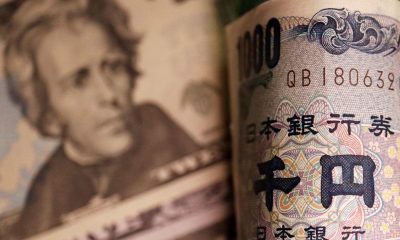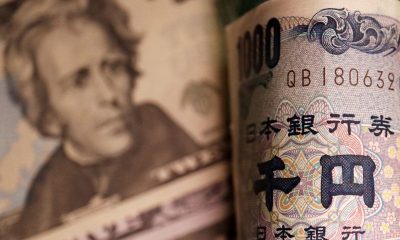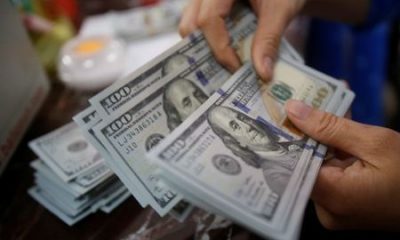Forex
US dollar drifts lower, consolidates gains; seen rising further
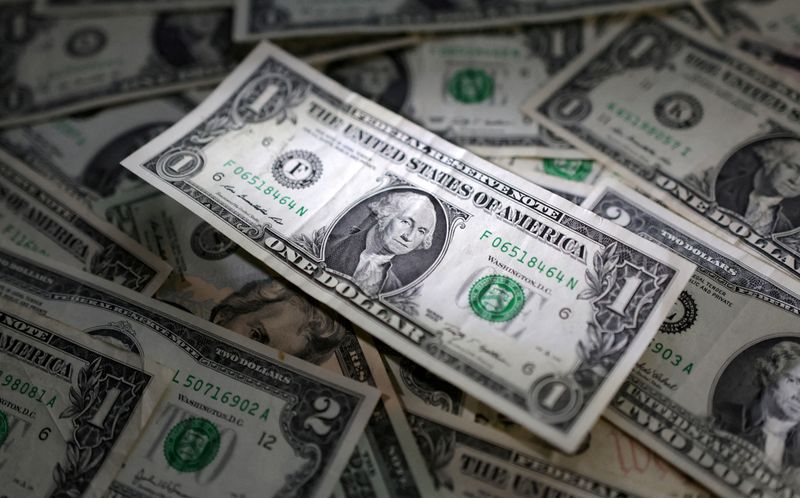
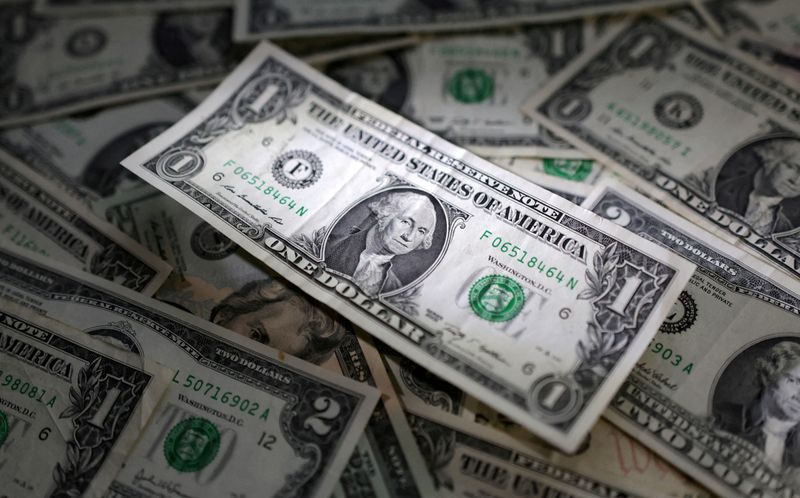
© Reuters. FILE PHOTO: U.S. dollar banknotes are seen in this illustration taken March 10, 2023. REUTERS/Dado Ruvic/Illustration/File Photo
By Gertrude Chavez-Dreyfuss
NEW YORK (Reuters) -The dollar slid from a fresh three-month high against a major currency basket on Wednesday, as investors consolidated gains following the previous session’s hotter-than-expected U.S. inflation report.
The inflation data for January pushed back bets on a first Federal Reserve rate cut to the middle of the year.
The greenback also weakened against the yen after Japan’s top currency officials warned against what they described as rapid and speculative yen moves.
The dollar eased 0.2% to 150.52 yen , not too far from a three-month peak hit against the Japanese currency on Tuesday. The U.S. unit has added about 10 yen in price since the start of this year.
Since Tuesday’s data showed that the U.S. consumer price index (CPI) gained 3.1% in January on a year-on-year basis, compared with an expected 2.9% rise, fed funds futures have priced in no rate cut in March and a nearly 80% chance of easing at the June meeting, according LSEG’s rate probability app. Two weeks ago, markets had expected the first rate cut to happen in May.
Futures are also pricing in about three rate cuts of 25 basis points each this year, down from about five cuts two weeks earlier.
The , which measures the U.S. currency’s value against six other major currencies, slipped 0.1% to 104.72, having touched a fresh three-month high of 104.97.
“The stronger dollar is now the path of least resistance. We don’t think it’s time yet to fade those moves,” said Vassili Serebriakov, FX strategist, at UBS in New York.
“But things can change quickly and we have retail sales on Thursday, although we do expect a robust number again. That should support dollar strength.”
Economists expect a 0.1% decline in U.S. retail sales in January, from a 0.6% rise in December, a Reuters poll showed.
UK INFLATION
Sterling was down 0.2% against the dollar at $1.2563, after briefly touching a more than one-week low, as data showed UK inflation did not accelerate in January as expected. This may relieve some of the pressure on the Bank of England (BoE) to keep rates steady for longer.
UK inflation stood at an annual rate of 4.0% in January, unchanged from December, but lower than economists’ forecast for a 4.2% rise.
Money markets see a 51% chance of a BoE rate cut in June and a 75% chance of one in August, according to LSEG’s rate probability app.
In Japan, Finance Minister Shunichi Suzuki told reporters the government is closely watching the currency market, particularly dollar/yen, adding that “rapid moves are undesirable for the economy.”
Earlier, Japan’s top currency diplomat Masato Kanda said the nation would take appropriate actions on forex if needed.
Japan intervened in the currency market three times in 2022 when the yen plunged to 32-year lows near 152 to the dollar, buying dollars and selling the Japanese unit.
Elsewhere, the euro gained 0.2% against the dollar to $1.0720 amid a slew of euro zone economic data. It earlier touched a fresh three-month low of $1.0695.
Euro zone employment rose 0.3% quarter-on-quarter and 1.3% year-on-year in the fourth quarter. According to a Reuters poll, employment was expected to rise 0.2% quarter-on-quarter and 1.1% year-on-year.
Data also showed economic growth in the region was flat in the last three months of 2023 compared with the previous quarter and up 0.1% versus the same period in 2022.
In cryptocurrencies, bitcoin rose 4.1% to $51,612, hitting its highest since December 2021 above $52,000.
(Reporting Gertrude Chavez-Dreyfuss; Additional reporting by Joice Alves in London and Kevin Buckland in Tokyo; Editing by Mark Heinrich, Kirsten Donovan and Marguerita Choy)
Forex
Yen surges on suspected intervention, 160 seen as key level

By Kevin Buckland, Tetsushi Kajimoto and Gertrude Chavez-Dreyfuss
TOKYO/NEW YORK (Reuters) -The yen surged against the dollar in early Asian hours on Thursday on what traders suspected was another round of intervention by Japanese authorities to stop a sharp slide in the currency, with the 160 level seen as a key line of defence.
The dollar tumbled to precisely 153 yen from about 157.55 yen for reasons that were not immediately clear, but traders and analysts were quick to attribute it to dollar selling ordered by Japan’s Ministry of Finance to support a currency languishing at 34-year lows.
The latest move came in a quiet period for the currency pair, after the U.S. stock market had closed and with the Federal Reserve’s monetary policy meeting ending hours earlier.
The dollar was already on the back foot after Fed Chair Jerome Powell confirmed that the central bank’s bias was towards interest rate cuts, even if the timing has been delayed by sticky inflation.
“There’s no doubt the MOF intervened,” said Daisaku Ueno, chief currency strategist at Mitsubishi UFJ (NYSE:) Morgan Stanley Securities, who says officials have set 160 yen per dollar as their “final defence line.”
“This morning’s intervention is proof that Japanese authorities will intervene any time of the day, and any day of the year,” he added. “They will continue to intervene.”
Bank of Japan money market projections for cash balances later showed more than 9 trillion yen ($57.96 billion) discrepancy with broker expectations. It suggests intervention around that size – which would mark a new record – though factors other than foreign exchange intervention can influence money market balances.
remove ads
.
Additionally, Columbia University academic and former finance ministry executive Takatoshi Ito told Reuters it was plausible Japanese authorities intervened to signal they see 160 yen to the dollar as their line in the sand.
The yen has been under pressure as U.S. interest rates have climbed and Japan’s have stayed near zero, driving cash out of yen and into higher-yielding assets.
The pressure has intensified since March as expectations for Fed rate cuts receded, reinforcing the yen’s status as a cheap funding currency.
When contacted by Reuters, Japan’s vice finance minister for international affairs, Masato Kanda, who oversees currency policy, said he had no comment on whether Japan had intervened in the market.
A U.S. Treasury spokesperson also declined to comment on the move in the currency pair.
Yellen told Reuters last week that currency interventions were acceptable only in “very rare and exceptional circumstances” when markets were disorderly with excessive volatility.
CHALLENGING
The difficulty in arresting the yen’s slide has been made clear by the speed at which the currency has reversed direction after its spike.
As of 1000 GMT, the yen was 0.5% lower at 155.23 per dollar, giving up some of the ground it gained overnight.
And it remains down about 10% against the dollar this year amid receding bets for near-term Fed rate cuts, while the Bank of Japan has signalled it will go slow with further policy tightening after its first rate hike since 2007 in March.
The gap between long-term government bond yields in the two countries is a yawning 376 basis points, which helped push the yen to the weakest since April 1990 at 160.245 per dollar on Monday. Official data earlier this week suggested a sharp rebound that followed was due to Japanese intervention totalling about $35 billion, close to a record amount. The finance ministry has consistently declined to say whether it was behind the move.
remove ads
.
($1 = 155.2900 yen)
Forex
Yen pares some of sharp rise after suspected intervention, dollar steady
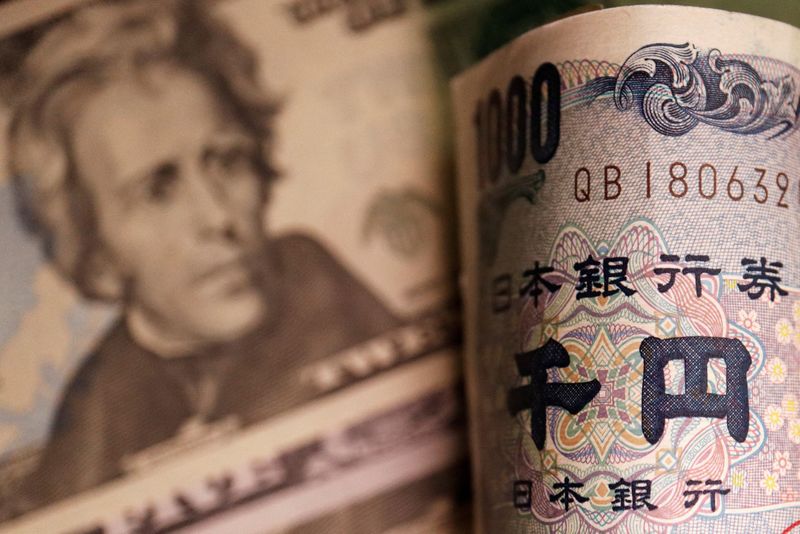
By Samuel Indyk and Kevin Buckland
LONDON (Reuters) -The yen fell slightly against the dollar on Thursday, reversing direction after a sudden surge late on Wednesday that traders and analysts were quick to attribute to intervention by Japanese authorities.
The yen was 0.4% lower at 155.18 per dollar as of 1055 GMT, retracing about half of its late Wednesday surge from around 157.55 to exactly 153 over a period of about 30 minutes.
The sharp move on Wednesday came in a quiet period for markets after Wall Street had closed, and hours after the U.S. Federal Reserve had wrapped up its policy meeting.
The dollar was already on the back foot as Fed Chair Jerome Powell confirmed the central bank’s easing bias, even as he reiterated that sticky inflation meant interest rate cuts may be a while in coming.
“It signals to markets that they are willing to go at any time, day or night,” said Jane Foley, head of forex strategy at Rabobank.
“It shows authorities are very cognizant about the conditions as when they moved the dollar was already on the backfoot because Powell was not as hawkish as he could have been.”
Japan’s vice finance minister for international affairs, Masato Kanda, who oversees currency policy at the MOF, told Reuters he had no comment on whether Japan had intervened in the market.
The dollar remains up more than 10% against the yen this year, as traders push back expectations on the timing of a first Fed rate cut, while the Bank of Japan has signalled it will go slow with further policy tightening after raising rates in March for the first time since 2007.
remove ads
.
INTERVENTION?
The gap between long-term government bond yields in the two countries is 371 basis points. That helped lift the dollar to a 34-year peak of 160.245 yen on Monday and also spurred a sharp reversal, which official data suggested was because of Japanese intervention totalling about $35 billion.
The Bank of Japan’s official data on Thursday indicated Japan may have spent a further 3.66 trillion yen ($23.59 billion) on Wednesday in its attempt to shore up the currency.
“I don’t think intervention alone can cap dollar-yen,” said Niels Christensen, chief analyst at Nordea.
“The Bank of Japan continues to be reluctant to move the key rate higher, which is one reason why I expect the market to test the upside in dollar-yen.”
The , which measures the currency against the yen, euro, sterling and three other major peers, was little changed at 105.72 on Thursday, following a 0.6% retreat on Wednesday from near six-month highs.
The euro was down 0.1% at $1.0705, after climbing 0.5% in the previous session.
Sterling slipped 0.1% to $1.2513, paring back some of Wednesday’s 0.3% rise.
As widely expected, the Fed held rates steady on Wednesday and Powell stressed it “will take longer than previously expected” for policymakers to become comfortable that inflation will resume the decline towards their 2% target. At the same time, he characterized the risk of more hikes as “unlikely.”
“There was a collective sigh of relief in the financial markets after the Fed refrained from increasing its hawkishness,” said Jack Mclntyre, portfolio manager for global fixed income and related strategies at Brandywine Global.
remove ads
.
“Think of this outlook as ‘high for longer’ as opposed to ‘higher for longer.’ The latter implies rate hikes, which is not today’s story.”
Hotter-than-forecast Swiss inflation in April drove the Swiss franc higher against both the euro and dollar.
“The probability of another cut (from the Swiss National Bank) in June is a little less likely but I think they will still be quite pleased with the inflation situation,” Nordea’s Christensen said.
“I would still expect another cut in June, especially if the European Central Bank also cuts rates next month.”
Forex
Dollar stabilizes after Powell speech; labor market data in focus
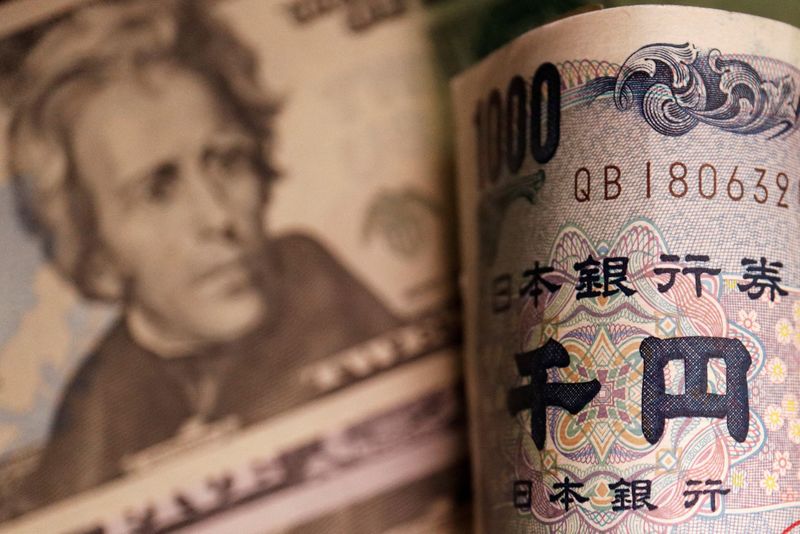
Investing.com – The U.S. dollar stabilized Thursday after a sharp overnight drop in the wake of Fed Chair Jerome Powell ruling out any rate hikes, while the Japanese yen was volatile amid intervention talk.
At 06:00 ET (10:00 GMT), the Dollar Index, which tracks the greenback against a basket of six other currencies, traded 0.1% higher at 105.645, after falling 0.6% overnight.
Powell rules out further rate hikes
The kept interest rates unchanged at the conclusion of its latest policy-setting meeting on Wednesday, as widely expected, with Fed Chair acknowledging that fighting inflation was taking longer than expected.
However, he largely ruled out interest rate hikes this year, which surprised the dollar bulls given recent stronger-than-expected inflation data.
“While the Committee added a hawkish acknowledgment of the ‘lack of further progress’ on inflation so far this year to its statement, Chair Powell offered a dovish message in his press conference,” economists at Goldman Sachs said, in a note.
“We have left our forecast unchanged and continue to expect two rate cuts this year in July and November,” they added.
Economic data is going to be studied even more closely now, as Powell emphasized the need to be data-dependent, and there are weekly due for release later in the session.
However, the first key data point arrives on Friday, with the closely watched U.S. employment report.
are expected to have risen 243,000 in April, a drop from just over 300,000 the prior month, but still indicative of a healthy labor market.
remove ads
.
Eurozone manufacturing still weak
In Europe, traded 0.1% lower to 1.0699, after data showing that the eurozone’s manufacturing sector remains in the doldrums.
The final eurozone , compiled by S&P Global, fell to 45.7 in April from March’s 46.1, below the 50 mark denoting growth in activity for a 22nd month.
The bloc’s economy recovered last quarter from a mild recession and expanded 0.3% quarter-on-quarter in January-March, official data showed earlier in the week, but any further growth is unlikely to come from the region’s manufacturing sector any time soon.
traded 0.1% lower to 1.2509, trading in a tight range, with the next economic data release of note being Friday’s .
This is expected to show an increase to 54.9 in April, from 53.1 the prior month, suggesting that the U.K.’s dominant services industry remains in a healthy state, potentially offering the Bank of England room to delay interest rate cuts.
Yen volatile; more intervention at work?
In Asia, rose 0.5% to 155.26, with the pair making something of a recovery after it suddenly fell more than 3% on Wednesday from late Tuesday levels, prompting talk of more intervention by the Japanese authorities to support the yen.
The USDJPY pair had tumbled from 160 on Monday, which traders said was the new line in the sand for Japan when it came to yen weakness. But the factors weighing on the yen – chiefly a dovish Bank of Japan and a wide gap between local and U.S. rates – are expected to remain in play, limiting the effect of government intervention.
remove ads
.
Broader Asian currencies moved in a flat-to-low range, with the pair up 0.1% at 0.6531 even as data showed the country’s shrank to an over three-year low in March.

 Forex2 years ago
Forex2 years agoForex Today: the dollar is gaining strength amid gloomy sentiment at the start of the Fed’s week

 Forex2 years ago
Forex2 years agoHow is the Australian dollar doing today?

 Forex1 year ago
Forex1 year agoUnbiased review of Pocket Option broker

 Forex2 years ago
Forex2 years agoDollar to pound sterling exchange rate today: Pound plummeted to its lowest since 1985

 Cryptocurrency2 years ago
Cryptocurrency2 years agoWhat happened in the crypto market – current events today

 World2 years ago
World2 years agoWhy are modern video games an art form?

 Stock Markets2 years ago
Stock Markets2 years agoMorgan Stanley: bear market rally to continue

 Economy2 years ago
Economy2 years agoCrude oil tankers double in price due to EU anti-Russian sanctions



